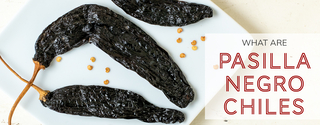What Are Pasilla Peppers
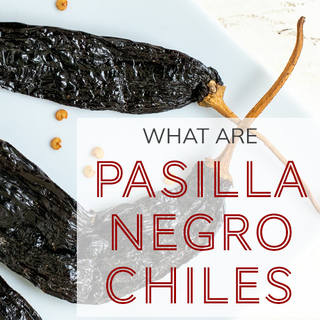
What Are Pasilla Chiles
Pasilla chiles are the dried form of chilaca peppers, botanically classified as Capsicum annuum. Pasilla peppers are also called chile negro, Mexican negro or pasilla bajio. This mild heat chile has a complex flavor. Chile Negro peppers are about 1 to 1-1/2 inches wide and 6 to 8 inches long.
Table of Contents
How Many Types of Pasilla Peppers Are There?
Substitutions for Pasilla Peppers
All About Pasilla Peppers
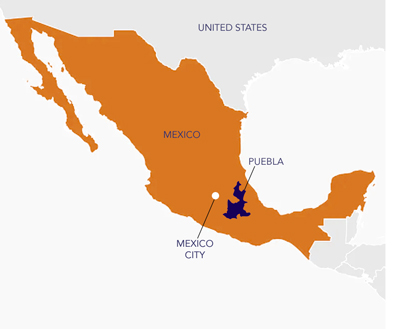 Pasilla (pronounced "pah-SEE-yah") translates to "little raisin" due to its dark, wrinkled skin. Pasilla chiles are one of the famous "holy trinity" of chiles used in Mexican moles, along with Ancho chiles and Guajillo chiles.
Pasilla (pronounced "pah-SEE-yah") translates to "little raisin" due to its dark, wrinkled skin. Pasilla chiles are one of the famous "holy trinity" of chiles used in Mexican moles, along with Ancho chiles and Guajillo chiles.
Chilaca (pronounced “CHIL-ah-cah”) are what Pasilla chiles are referred to when they are fresh. They are thought to be indigenous to the Puebla region just south of Mexico City and have been cultivated since ancient times. Radiocarbon dating has shown that chiles were being grown 6,500 years ago in this region of Mexico1.
You are likely here because you have heard of Pasilla peppers but aren’t sure if these are the chiles you need. We are here to help.
We’ve been sourcing, processing, and selling Mexican dried chiles for more than ten years. We work with Mexican restaurants, small-batch hot sauce manufacturers, and micro-breweries. Pasilla Negro chiles are the 7th most popular dried chile pepper we sell to Mexican restaurant customers.
We know Pasilla peppers, and this article covers all the questions you need to know about this chile. You will learn what they are, when and how to use them, where to find them, what to look for when buying, how to store them, and the differences between Pasilla chiles and other closely related peppers.
| Ingredients | Pasilla chiles |
| Also Called | Pasilla, chile negro, chile pasilla de Mexico, Mexican negro or pasilla bajio |
| Recommended Uses | Use in cream sauces, Mexican moles, salsa, and tortilla soup |
| Flavor Profile | Pungent and tangy with chocolate and raisin notes, rich in flavor with earthy undertones. |
| Scoville Heat Units | 1,000-1,500 SHU |
| Botanical Name | Capsicum annuum |
| Cuisine | Mexican, American Southwest |
| How To Store | Airtight container in a cool, dark place |
| Shelf Life | 1-2 Years |
| Country of Origin | Mexico |
What Do They Look Like?
Pasilla Negro chiles are 6 to 8 inches long and 1 to 1-1/2 inches wide. They are dark reddish-brown with glossy, wrinkled skin.
How Many Types of Pasilla Peppers Are There?
There are two types of Pasilla chiles grown in Mexico. Pasilla Negro, sometimes referred to as chile Negro, and

Pasilla de Oaxaca, also commonly called Pasilla Mixe.
Both chiles have a very similar appearance. The Pasilla Negro is 6-8 inches long and 1 to 1-1/2 inches wide. The Pasilla Mixe is 5-1/2 to 7 inches long and 1-1/4 to 2-1/4 inches wide. Both have glossy, wrinkled skin. The chile Pasilla is darker in color while the Pasilla de Oaxaca is redder.
These chiles are likely related, even though they are grown hundreds of miles apart. The better known Pasilla Negro are grown in south-central Mexico, while the chile Pasilla Mixe is native to the northeastern highlands of the Sierra Norte region of Oaxaca. To be an authentic Pasilla de Oaxaca pepper, it must be from that area.
The fundamental differences are in their heat and flavor profiles.
Pasilla Negro chiles are milder, coming in at 1,000 – 1,500 Scoville Heat Units. Pasilla de Oaxaca peppers are a spicier 15,000-20,000 SHU.
While both have a complex flavor profile, the Pasilla Mixe chiles are smoked and dried for 2-3 days, providing them with an almost meaty, porky note.
What Do They Taste Like?
Pasilla peppers have a rich, spicy, and tangy flavor with raisin and chocolate undertones and hints of earthiness.
How Hot Are Pasilla Peppers?
Pasilla Negro is a mild heat chile with a heat range of 1,000 to 1,500 SHU.
How to Use Pasilla Peppers
Pasilla Negro can be toasted, reconstituted, and stuffed with flavorful cheese blends, grains, and meats.
Once toasted, they can be rehydrated and blended into pastes to flavor hot sauces, marinades, or salsa. They can also be pureed and added to adobos, chili, cream sauces, enchilada sauce, mole sauce, soups, or tamales.
Another way to use them after toasting is to grind them into flakes or powder. They can then be combined with other chile powders to make dry rubs or seasonings for Mexican corn.
Pasilla Negro peppers pair well with duck, fruits, honey, chocolate, fennel, garlic, lamb, mushrooms, Mexican oregano, and seafood.
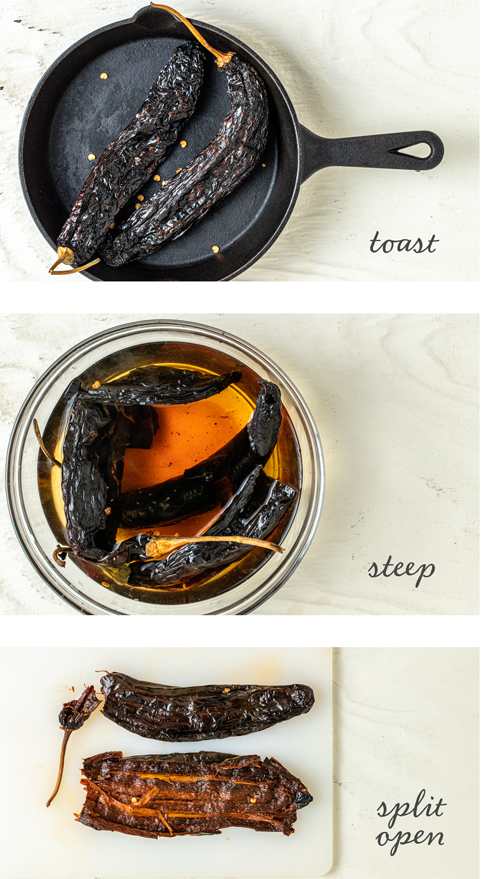 How to Deseed Pasilla Chiles
How to Deseed Pasilla Chiles
Pasilla Negro chiles are very easy to deseed. If you want to deseed them before toasting, pull the stem off, put a knife in the top of the chile and slit lengthwise down the pepper. You can also put a finger inside the top of the pepper and run that down the side, tearing it open. This is a mild pepper, so you don't have to worry about capsaicin impacting your skin. Pour out the loose seeds and pull off any remaining seeds or veins. It is now ready to toast.
Depending on what you plan to make with them, you can also wait to deseed these chiles until after you've rehydrated them. You can find that information at the end of the section on rehydration. If that is your preferred course of action, leave the stem on until after they are rehydrated. Toast them first before rehydrating and deseeding.
How to Toast Pasilla Peppers
Lay chiles flat in a dry pan, over medium-high heat. Toast for 30-45 seconds per side. You can press the chiles down with a spatula to create better contact with the pan and help them evenly toast. Let your nose be your guide to determine when they are done. They should smell sweet and smoky. If they start to smell like burnt bacon, they are overcooked.
Once Pasilla peppers are toasted they can be rehydrated or ground into flakes or powder.
How to Rehydrate Pasilla Peppers
Pour boiling water over chile Pasilla and let the peppers steep for 20 -25 minutes. After they’re rehydrated and soft, it’s easy to tear them apart with your hands and then mash or grind into a puree.
Another option is to leave stem on when you rehydrate the chile with boiling water, as above. When they are rehydrated and soft, slice along one side. Scrape the seeds, and then stuff the pepper with cheese or meat for chile rellenos or stuffed pepper appetizers.
You can retain this chile water for other uses. It is sweet with a pleasant touch of bitterness and just a hint of heat. Use in sauces, soups, or even in cocktails.
How to Make Pasilla Chile Powder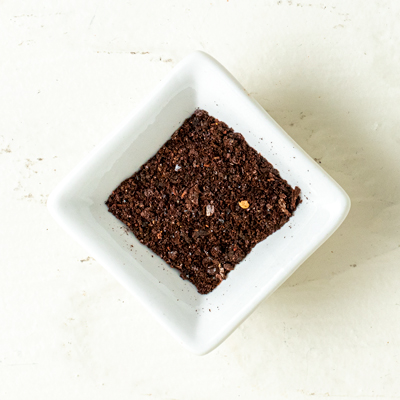
After toasting, remove the seeds from the chile; if there are a few that linger, that's fine. Tear the pasilla into pieces and put it in a spice grinder or mortar and pestle. Grind to the desired size. Use right away or store in an airtight container, away from direct sunlight.
How Long Do They Last?
When properly stored, dried Pasilla peppers can last in most pantries for 1-2 years. Keep chiles in an airtight container, away from direct sunlight, heat, and moisture.
We have found that it is best not to store them near your stove. When dried peppers are kept near the stove’s heat, the temperature in the storage containers can increase, which may cause the chiles to sweat.
After drying, dried peppers retain a small amount of water, which is why they are still pliable. When temperatures in the storage container rise, the chile begins to sweat out the water in its cell walls, changing the humidity inside the storage container. If the container is air-tight, as it’s supposed to be, the moisture won’t evaporate. That increases the likelihood of mold growth on the peppers.
When stored properly, dried Pasilla Negro chiles should remain pliable with vibrant aromas and color yet still feel dry to the touch. When dried peppers have no smell, look washed out in color, are brittle, or begin showing signs of mold, they should be discarded.
Ideal storage requires no direct sunlight, low humidity, and a consistent temperature between 60° - 72°F. In these conditions, chiles may be stored for 2-3 years. We feel this is unrealistic for most kitchens, though, and advise that you plan for 1-2 years of storage.
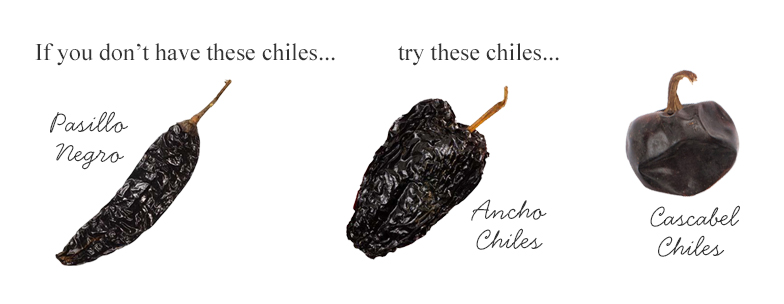
Substitutions for Pasilla Peppers
The Ancho pepper is the most accessible substitute for Pasilla Negro peppers, as they are frequently paired together. The heat level between the two is the same (1,000-1500 SHU), but the Ancho possesses an earthier and sweeter flavor. Cascabel chiles (1,500-2,500 SHU) are another frequently listed substitute, but they pack a tiny bit more heat. The flavor is also slightly different as the Cascabel is smoky and nuttier.
What to Look For When Buying Pasilla Peppers
Top-quality Pasilla Negro chiles will have a wrinkly exterior and sport a deep mahogany color. They should be somewhat soft and pliable. Most chiles should be whole and not torn or in pieces. Older chiles will be hard, brittle, and have many broken pieces.
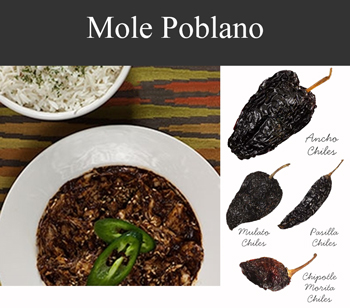
|
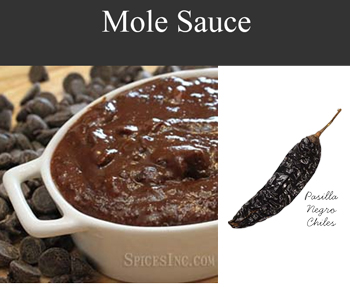
|
Where to Buy Pasilla Chiles
You can buy chile Negro peppers in Mexican markets, grocery stores, and at various online retailers. All shopping environments have unique plusses and minuses.
When buying from a Mexican market, you’ll usually find the staff knowledgeable about their dried peppers. These shops tend to be smaller, so they don’t have as much clout when buying their peppers wholesale. This results in higher prices. Slower moving inventory can also make it challenging to know the age of a chile, which can impact its flavor.
National grocery store chains can command better wholesale market prices. But the purchasing departments at grocery store chains are typically more concerned with getting the lowest price, not the most excellent quality possible. This can lead to inferior quality and mislabeled chiles, especially if they are close in their appearance to other chiles.
When buying dried chiles online, consider your retail source. Big-box online vendors offer convenience and often free shipping for members. Typically they are merely acting as a fulfillment center for a smaller company; they are certainly not experts in dried chiles. This means little oversight regarding the quality or integrity of the chiles at the point of sale.
Online specialty shops usually have a good selection. They are more likely to have the dried pepper expertise and know the difference between Pasilla chile pods and Ancho chiles.
Trustworthy shops also use procedures that guarantee their orders are filled correctly. Well-run businesses have little turnover, which leads to a more knowledgeable staff, so there is a familiarity with chile peppers throughout the handling process, which will allow customers to get the chiles they want and need.
Pasilla Negro peppers are easy to prepare and use and deliver a terrific, mild kick and a complex flavor to salsas, sauces, soups, and tamales. This is an excellent chile to experiment with to kick up your kitchen’s flavor and spiciness.
Mexican dried chiles have influenced food around the world for hundreds of years. Take a look at Mexico’s dried peppers and start making a spicy impact in your kitchen, too.
References
1 Kraft, K. H., Brown, C. H., Nabhan, G. P., Luedeling, E., Luna Ruiz, J. D. J., Coppens d’Eeckenbrugge, G., Hijmans, R. J., & Gepts, P. (2014). Multiple lines of evidence for the origin of domesticated chili pepper, Capsicum annuum, in Mexico. Proceedings of the National Academy of Sciences, 111(17), 6165–6170.

